Bulk cooking, is second only to planning ahead (I recommend meal plans!) when it comes to successfully sticking with a dietary change, whether you’re doing something strict like the Gut and Psychology Syndrome diet, or you’re just eating grain-free when you’re home, or you’re trying to get more nutrient density in your meals by basing them on protein, fat and, vegetables rather than carbs.
If you’ve been impressed with Sunday Meal Prep days that you see posted on Instagram, or you’ve peeked in a friend’s freezer to see meals frozen and organized like file folders, you may be intrigued about bulk cooking. Once it’s a habit (it’s a popular Sunday afternoon activity) it steamlines your life a bunch. It’s also a great way to prepare for a new baby, a season of training for a sporting event, or for evenings when you work late.
The great think about meal prep is that you can adjust what works for you. Start as simple as browning 3 times as much ground beef as you need the next time you make taco salad, or as elaborate as turning two weeks’ worth of groceries into 15 meals to be used throughout the month.
The tips below will help make your first bulk cooking experience rewarding, or help you fine-tune what you’ve been doing for years with a few shortcuts. Either way, you’ll reap the benefits of having delicious and healthy meals already prepared and waiting for you with minimal time investment.
The finished food from the groceries above
Cultured Salsa x 5 jars, 2 cups shredded chicken, 3 recipes Chicken Enchilada Spaghetti Squash Bowls, 8-10 servings Cauliflower Rice, 5 meals coconut-creamed spinach, 3 meals Crockpot Curry Beef, 4 Meals Bacon-Wrapped Meatloaf, 5 quarts full fat probiotic-rich yogurt, 16 broth cubes (homemade boullion).
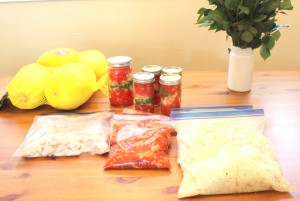
4 hours to finished meals
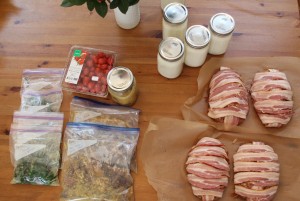
Shredded chicken, cauliflower rice, creamed spinach, curry beef, yogurt, bacon-wrapped meatloaf
Vary The Flavors in Your Meals
You may love Mexican food (who doesn’t?!) but you’re not going to want to eat taco salad 12 times this month. If you find yourself gravitating to the same spices (garlic, garlic, and more garlic anyone?) deliberately choose different flavor combinations like pineapple-sweetened pulled pork, ginger and garlic butternut squash soup, and curried beef with health-boosting turmeric and black pepper.
(to download the recipes that I made with the pictures shown, click here)
Manage Your Time Realistically
What other obligations do you have while you’re cooking? Do you have young children that you’ll also be attending to? Older kids who are going to want to help (tips on this below)? A business that you’re going to take calls for during your cooking time? Or do you have the whole day to devote to finding recipes, grocery shopping, cooking, storing, and clean up?
No matter what your situation, bulk cooking is fast paced, and a lot of work, so you may tire more quickly than you expected.
Prioritize Your Recipes
Prioritize cooking vegetables that will go bad in the fridge, and meat (like chicken) that you need for other things (chicken stock).
Choose protein and vegetables since they are most nutrient dense, yet the least exciting to prepare for. If you look at anyone’s Pinterest page, you’ll usually see a bunch of pins for sweets and desserts, and not so many for meat and vegetables. We’re wired to be more excited about sugar than we are protein, so that’s why it’s essential to make our protein and vegetable dishes as easy as possible for the future. If all we have to do is thaw something and toss it in the oven or crockpot, it’s suddenly super easy – and our health will thank us for it!
Last, do the fun baked goods like muffins or scones. You want to be able to bail on your last few recipes in case life gets in the way.
The one thing you do NOT want to bail on is kitchen clean up – so if you’re in doubt, stop early and clean up!
Quality Over Quantity Kitchen Tools
One of the biggest time savers with bulk cooking is that you can use the same appliance the entire afternoon with only rinsing it between uses. One professional chef’s knife, a high-quality food processor, nice large cutting board, excellent stock pots, and a durable cast iron skillet all get used nonstop all afternoon. Buying (or borrowing) equipment that isn’t frustrating is efficient, and takes up much less counter space, than a bunch of specialty gadgets.
Source Your Food Well
Since we’re cooking so much at once, it’s worth it to compare prices and quality of ingredients. If you can order your meat for pickup from a local farmer, they might put together a box that is exactly what you need. Some stores are going to have higher quality eggs or veggies at better prices, and others will be better for bulk spices and sea salt, and still others for canned goods and honey.
This is where I buy our groceries for bulk cooking here in Montana, it varies from location to location:
- Beef and Pork (local farm) (or buy online)
- Eggs, Greens, Squash, Onions, Cauliflower, Almond Flour, Chicken, Bacon, Butter, Fruit (Costco)
- Milk, Cream, Yogurt, Coconut Milk, Honey sometimes (Locally owned discount grocery store)
- Produce that Costco didn’t have, misc meat that the local farm didn’t have (Higher end locally owned grocery store in town)
- Spices, Herbs, and Salt (Mountain Rose Herbs)
- Coconut flakes, flour, and oil (Tropical Traditions)
Use Recipes That You Already Know You Like
Second only to waking up the next morning to every dish in your kitchen dirty because you didn’t allow enough time and energy to clean up, the most disappointing thing that can happen with bulk cooking is that you end up with a bunch of food that you don’t like the flavor or consistency of.
Tripling your family’s favorite recipes, or quartering recipes designed for bulk cooking to test them in small batches, is always recommended over trying new things in huge quantities.
Personally we love coconut flour waffles, and I love making a ton of those for my freezer, but some people don’t love them, especially if they’re used to wheat-based waffles.
Always always always try the recipes ahead of time!

Start With a Clean Kitchen, Make Temporary Kitchen Changes
It may seem weird to scrub your kitchen just to go in and mess it up again, but starting with a sprakling clean work surface will make food prep easier and more enjoyable, and make cleanup at the end easier as well.
In addition to cleaning your kitchen, move any appliances (like the coffee maker) that you won’t be using for bulk cooking, and keep the trash can out where it’s near your work area, not in the cabinet.
Bring a gentle soap into the kitchen. Due to frequent hand washing between recipes, using dish soap will dry out your hands. We like Honest soap for frequent washing.
Finally, move any decorations that sit on the counter top – you’ll want the largest work area available.
Enlist Help, If You Can
Even young children can help roll meatballs, scrub veggies, or unpack groceries. If you can get your kids to help, it not only helps you get things done quickly, but it also keeps them busy and from asking for your attention. When I have a job like this that is beyond normal chores, I do reward them with a prize for a job well done, this keeps them on task, and if they finish their task, it keeps them busy through the rest of my cooking time.
Popular in our home: Lego sets, a new app for the Kindle, Calvin and Hobbes books.
Use All Your Equipment At Once
When choosing what to cook next during your bulk cooking day, try to have all your appliances and pots in use at once, and try to order your cooking so that raw meat is done last because we have to wash everything it touches with hot water and soap, rather than just rinsing like we do with veggies.
An example from my cooking afternoon (4 hours start to cleanup) (download recipes and further instructions by clicking here):
- Heat milk for yogurt in one pot
- Bake two chickens in another stock pot
- Mix enchilada sauce in large sauce pan
- Shred cauliflower for cauliflower rice and set aside
- Shred mushrooms and onions for meatloaf in food processor
- Shred onions and other veggies in food processor for curry, cultured salsa.
- Shred cheese in food processor as needed
- Move yogurt to jars to culture, use rinse yogurt pot and use for creamed spinach
- Assemble cultured salsa
- Everything that uses raw meat is done now that the raw veggies are either cooking or put away
- Move cooked chicken to cutting board to cool, then the bones/skin to large crockpot to make stock
- Cook cauli rice in the stock pot that the chicken was roasted in since it uses chicken stock anyway, no need to rash
- Muffins in stand mixer (if time)
- Waffles can be mixed in the blender and cooked in the waffle iron (if time)
Storing your Meals: Ditch the Plastic Guilt
Yes, I know that glass is the ideal thing to store food in. And for leftovers, or food that is going to be eaten within the next couple days I do use glass! But when it comes to freezing, I use plastic bags and containers due to their ability to lie flat or stack, and not shatter all over the kitchen if dropped. Frozen glass doesn’t stack well, and is slippery and crazy brittle.
If you’ve been avoiding bulk cooking because you don’t feel like you have the best containers to store your food in, consider getting rid of that guilt and giving yourself permission to make life a little easier.
When we bulk cook we are helping the environment even if we do use plastic bags by:
- Purchasing food in bulk, eliminating excess packaging
- Eliminating food waste due to veggies or meat going bad in the back of the fridge
- Using less water and electricity to wash dishes over and over again for each meal
- Reducing the amount of fuel needed to run to the grocery store for last minute food items during the dinner scramble.
And we’re helping our health by having homemade well-sourced nutrient-dense meals easily, with much less stress.
Freeze flat
When possible, freeze your zip-top bags flat. If you live in a cool area and it’s winter, you can even do this on the back porch (watch for animals – the neighborhood cats might take interest). Just lay the bags flat on the deck or on a table, and move to the freezer once frozen. Freezing flat helps keep the freezer organized.
Reheating Tips
Reheating the meals that we cook takes a little planning ahead, but it’s easy to set aside 5 minutes in the morning to pull out a meal to thaw, or dump something in the crockpot.
I really like having a small crockpot so that I can have things like curry chicken once, without having to make enough for all week. Crockpots tend to burn things and cook unevenly unless they’re 1/2 full, so a small crockpot can be a great investment. They don’t cost that much either.
To thaw a meal when you forgot to pull something out in the morning, fill a large bowl or stock pot with barely warm water, and place the zip-top bag right in the water.
If you pull out a meal, and then don’t end up using it, store it in the fridge in a bowl – that will contain any accidental leaks if the plastic bag was punctured a little bit sometime in the process. Then use within the next day or two.
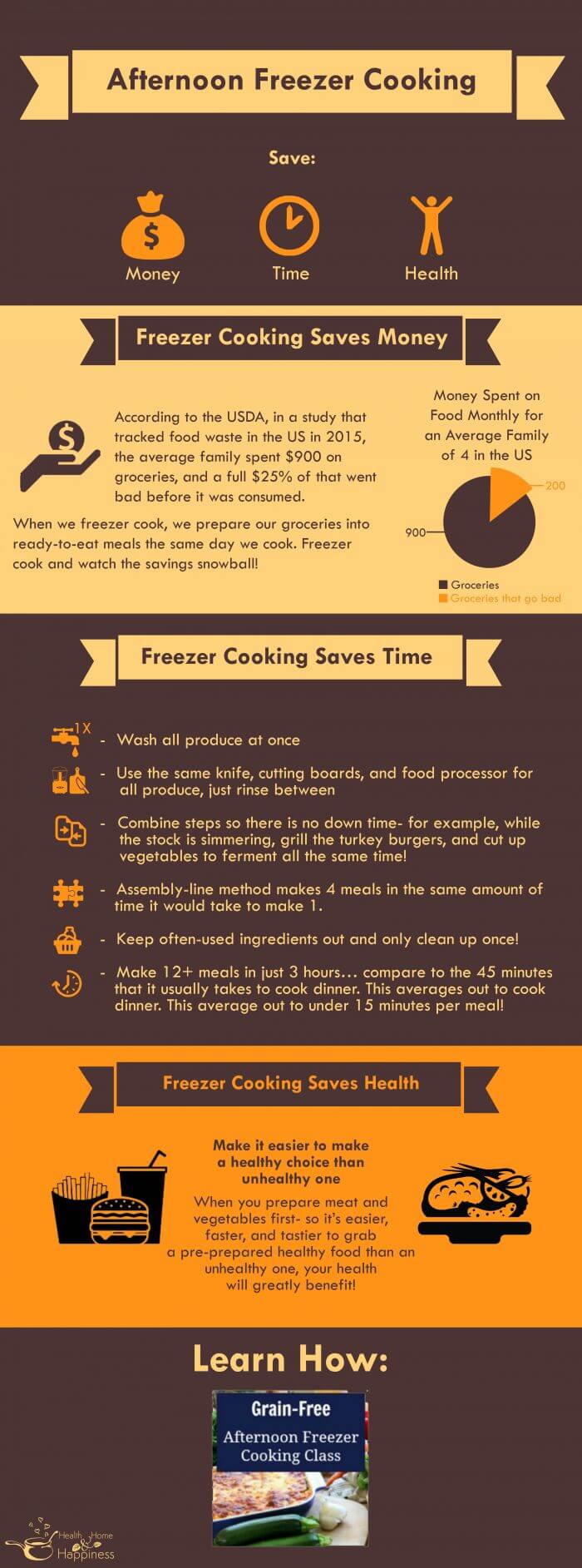
Learn how to heal leaky gut

60-page ebook of all my best GAPS Diet (Gut and Psychology Syndrome) articles all in one place.

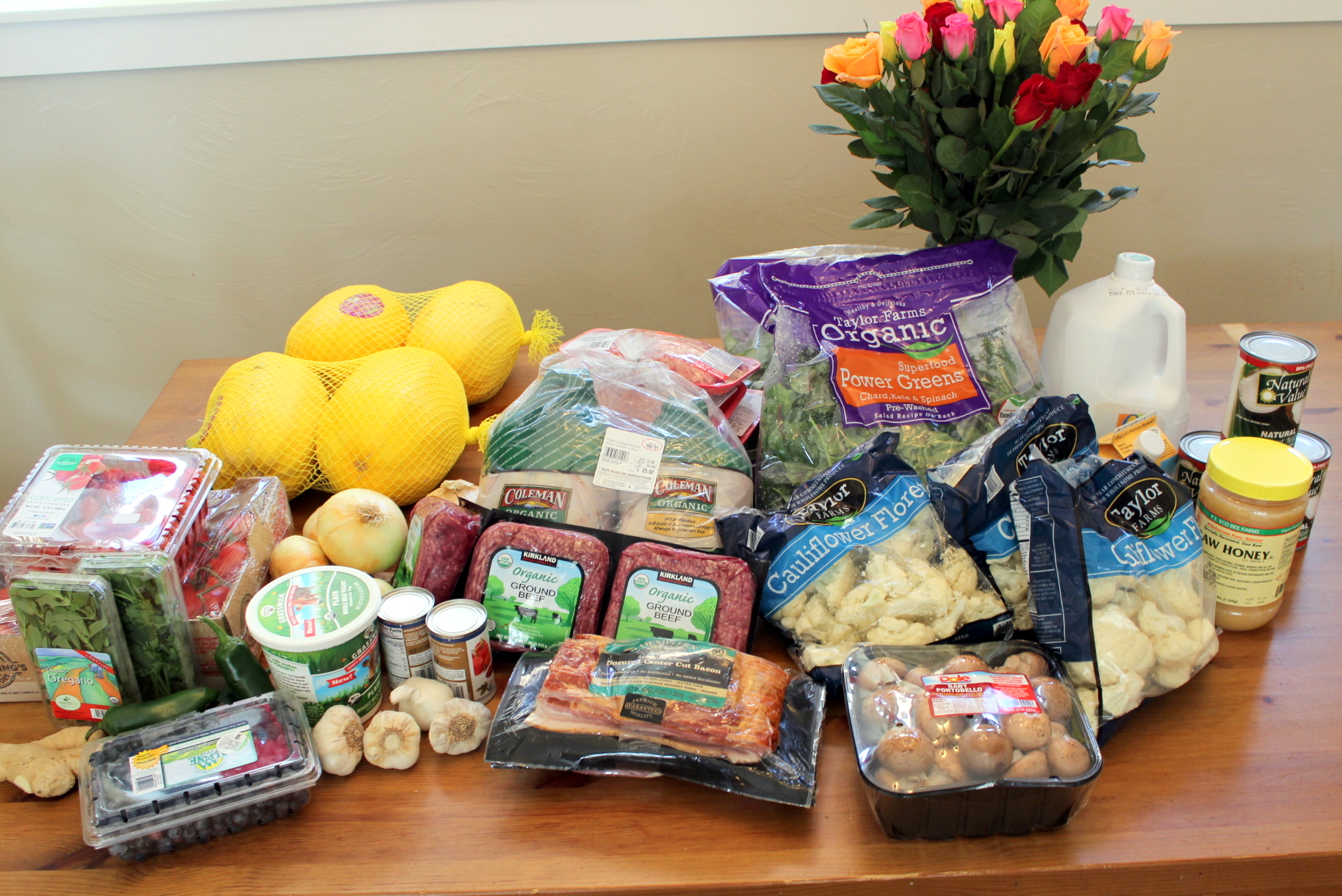
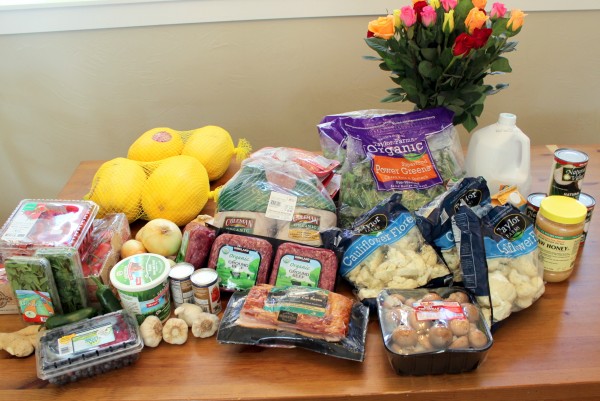
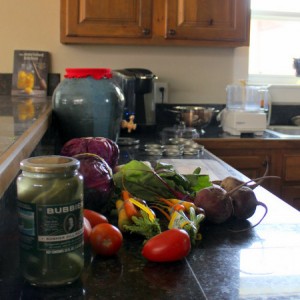
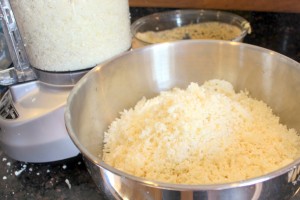
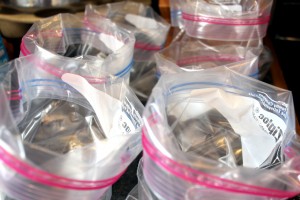

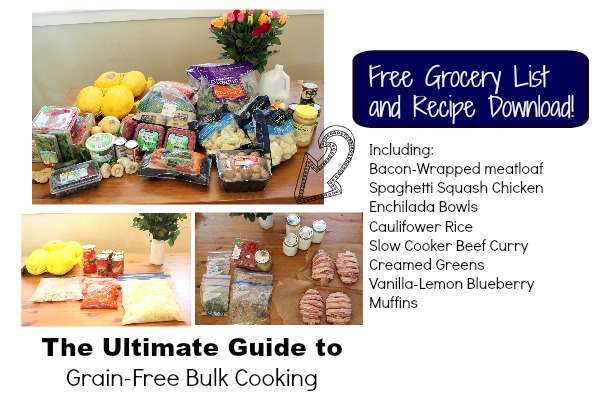

I’m always looking for tips on bulk cooking. Your post was an encouragement just when I needed it. Thank you!
I have a Hamilton Beach slowcooker that has three different bowls–2 qt, 4 qt, and 6 qt. I really like that I can switch out bowls according to what I am cooking since I like to cook a large batch to freeze, or use the 2 qt for a small dish (or to warm up a side dish).
Fantastic advice! We just got through our bulk cooking day and I’m exhausted. Definitely need to be better organised next time. We did GAPS but being in a hot Western Australian summer, we got tired of heavy crockpot stews at lunch time. We wanted salads! Now we do soup for breakfast (still getting that soup in! And what else do you eat when you have 100 limitations?), salad & cold meat for lunch, and various mains at dinner. We buy a whole sheep and pre-cook some more cold meats. Other cuts I prep the curry or marinade and freeze it raw, then dump the contents in the slow cooker in the morning. Then we do 30+ soup meals (5 different recipes), which is the most time consuming part. Once a week I also prep out fresh veggies & salads… We love mason jar salads!
Sorry for the long comment but I was excited to see someone doing what we are doing. And I agree 100% – ditch the plastic guilt! I use glass for everything, but there is no way we could do this without our freezer bags! What are you using to hold your bags open?
I am so happy that I found your post! In regards to the bacon wrapped meatloaf, should they be baked prior to placing into the freezer? Thank you!
I bake after :)
What do you freeze casserole dishes in? Glass? I’d love to do aluminum throw away ones but I don’t want my son eating leached aluminum food. ) :